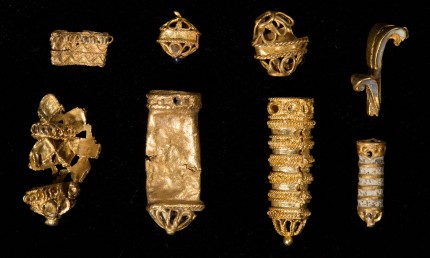
A group of tiny gold objects from the early 16th century may be all that’s left of an extremely snazzy hat. Twelve small gold artifacts have been found in the Thames mud by eight different people over the past few years. When treasure hunters and licensed Thames mudlarks find artifacts of note in the tidal muck of the river, they bring it to archaeologist Kate Sumnall, the Portable Antiquities Scheme’s Finds Liaison Officer for London. Sumnall realized that the gold artifacts are very similar and since they were all found in one area of the Thames foreshore, she believes these tiny gold objects were originally been attached to a single piece of clothing which has long since rotted away. A hat is a likely candidate, since a strong gust of wind could have dislodged it from its wealthy owner’s head and driven it into the river whereas a jacket, say, tends to stay put.
Such metal objects, including aglets – metal tips for laces – beads and studs, originally had a practical purpose as garment fasteners but by the early 16th century were being worn in gold as high-status ornaments, making costly fabrics such as velvet and furs even more ostentatious. Contemporary portraits, including one in the National Portrait Gallery of the Dacres, Mary Neville and Gregory Fiennes, show their sleeves festooned with pairs of such ornaments.
Several of the pieces have the same gold loops and gold rope design. A few are inlaid with enamel or colored glass. Because they’re so small, the amount of gold is minimal — less than could fill an egg cup, apparently — but any gold at all has to be reported to the local Finds Liaison Officer who documents the discovery before passing it on to British Museum experts who assess it for the coroner’s inquest. At the inquest the coroner decides whether the object qualifies as treasure under Britain’s Treasure Act — anything more than 300 years old containing more than 10% gold or silver — and thus belongs to the crown.
Sumnall works at the Museum of London Docklands. Once these artifacts have been declared treasure (a foregone conclusion because of the gold), the museum wants to acquire the group for its collection.

Does anyone think the British law on finding buried items is insanely dictatorial? I think if I find an object, it is mine and the landowners, and screw the crown. What a bunch of bull crap to go through after spending all day, or days, in the dirt, the dictatorial grey suited creeps. :p
The total amount of gold might have been small, but the designs were fine and the craftsmanship was advanced. Presumably wealthy Tudor families could ask for the exact shapes they wanted.
As a relic hunter and metal detectorist here in the US, I think the British setup is pretty fantastic. Important finds are reported to the authorities who, in cases such as hordes can come and complete the excavation in context. If it’s declared treasure, the finder and landowner split the value of the find. It ensures archaeologists are made aware of the artifacts, and encourages landowners to allow people to come search their land. Of course in this particular case, there is no context to be had with regard to the find location, being on a river bank and all, but generally, I wholeheartedly approve of the Portable Antiquities Scheme.
Very cool! Can easily imagine that Tudor era hat flying off into the sky, floating a moment, and then sinking out of sight while its owner looked on in dismay.
I’m all for the law, as it discourages treasure hunting: the enemy of our shared human heritage.
Aye! Down with the British! Down with King George!
Yes, why on earth would anyone be interested in their own heritage. Better off leaving it buried with the worms and varmits.